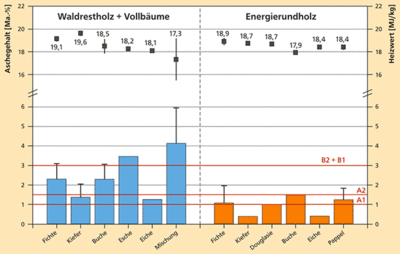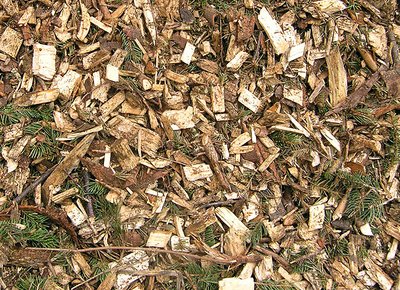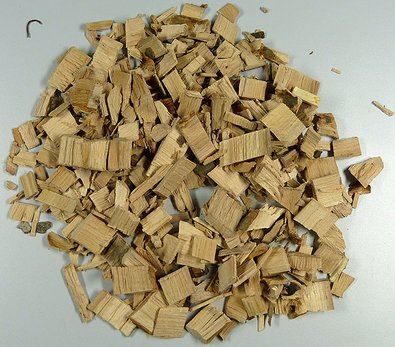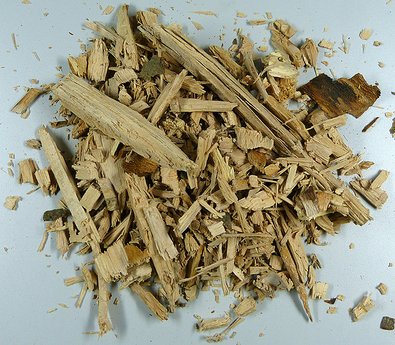The quality of forest woodchips as a fuel varies considerably due to the sheer abundance of possible raw materials and processing methods. Depending on the type of woodchip, the fuel contains different proportions of leaves, needles and bark. There are the high quality “premium woodchips” produced from fuel logs on the one hand, and classic “forest residual-wood woodchips” on the other. The machine used to make the woodchips, the process settings, and the mode of operation in the forest also all bear an influence on the properties of the fuel.
This means that the quality of forest woodchips can vary enormously, something which still tends to play a secondary role for many consumers. However, to run smoothly, small boiler units with power ratings of less than 100 kilowatts (kW) require a clearly defined and consistent quality of fuel. The standards fuel is expected to meet in terms of purity and high quality will continue to rise in the long term.
Fuel quality of forest woodchips
The quality of forest woodchips as a fuel is clearly defined according to a series of physical and material parameters. These include:
- Water content
- Ash quality and content
- Calorific value
- Particle size and shape
The water content of the fuels has a direct influence on the actually usable heat produced and also on the emissions profile of the boiler system and the storability of the fuels. Particle size and shape are crucial for the flow behaviour of the bulk material, as the wrong shape or size may for example jam the screw conveyor or cause bridging in the store.
ISO standard fuel specifications

Tab. 1: Size classes for wood chips according to the German norm DIN EN ISO 17225-4.
In Germany, the DIN EN ISO 17225 series of standards regulates the fuel quality of forest wood chips. Whereas Parts 2 and 3 of the norm refer to wood pellets and wood briquettes, Parts 1 and 4 are particularly relevant for wood chips.
Part 1 of the norm establishes general specifications for biogenous solid fuels and criteria for the classification of the possible raw materials. Part 4 concerns the specific use of woodchips in small boiler units. It defines three chip sizes (P16S, P31S, P45S) (Tab. 1), as well as standards for
- the maximum proportion of fine material,
- the maximum proportion of coarse material permitted,
- the maximum particle length and
- the maximum cross-section of the particles.
The norm also describes four classes of quality (A1, A2, B1, B2). For each class there are certain requirements to be met in terms of the raw material used, although forest wood as a natural, untreated raw material is permitted for all four quality classes. As well as physical fuel quality requirements (water content, ash content, heating calorific value, bulk density) in all four quality classes, there are requirements in classes B1 and B2 for the material properties of the fuel (element concentrations).
A1 and A2-classified fuels are mainly used in private woodchip boilers with power ratings up to approx. 100 kW and also in so-called wood gasifiers (fixed-bed gasifiers). Classes B1 and B2 are recommended for use with smaller commercial and municipal heat networks up to a maximum thermal power output of one megawatt (MW). Boiler systems exceeding outputs of 1 MW often have their own individual quality agreements. Generally, the use of the DIN EN ISO 17225-4 woodchip standard is voluntary rather than a legal requirement.
Field studies on fuel quality
Field studies were carried out to analyse the physical fuel properties (water and ash content, calorific value, bulk density, particle size and shape) of a large number of samples of woodchips made from forest residual-wood, whole trees and fuel roundwood. The results were evaluated
- according to DIN EN ISO 17225 (Parts 1 and 4),
- with regard to the raw materials used (tree species, grade of timber) and
- with regard to the machine settings (blade sharpness, sieve basket, etc.).
Drying of material fresh from the forest, depending on the application
The water content of freshly harvested forest woodchips was an average of 49 Ma.-% (mass percent). The highest water content levels were measured for woodchips made from coniferous wood. Larger heating plants may well cope with water contents of 50 Ma.-%, but smaller boiler systems often require water contents of less than 20 % or 35 Ma.-%. Depending on the application, woodchips from freshly harvested raw material therefore have to be dried.
In practice they are often dried using natural drying processes such as the storage of the wood chips in bulk piles. In this case the air surrounding the pile is warmed by microbiological degradation processes. As a result, there are sometimes very high dry matter losses of 20 to 40 % over the entire storage period. Woodchips are also dried using aeration technology. This always entails additional expenditure of energy and labour for the manufacturer.
A third possibility is drying the timber before chipping. The wood to be chipped is harvested in the spring and stored until the following heating period – i.e. over the course of a summer. The water content can be reduced in this way to values of around 31 Ma.-%. Dry matter losses should be minimised because of the smaller surface in comparison with the small particles in the woodchip pile. This type of drying is to be recommended, but may also be impossible under certain circumstances: if there is a risk of spruce crown material being used as a potential breeding ground by bark beetles, it must be chipped immediately.
Raw material determines calorific value and ash content

Fig. 2: Average calorific value (points) and average ash content (columns) of wood chips made from forest residual wood and fuel roundwood. Red lines show the limits for ash content for quality classes A1 to B3 according to DIN EN ISO 17225-4. Columns without error bars represent individual measurements (n=1), and otherwise n ≥ 3.
The calorific value of the samples that were analysed was between 16.0 and19.8 MJ/kg (mega joules per kilogramme) (Fig.2). The highest calorific values were measured for forest residual wood from coniferous trees - because of the high proportions of resin and lignin in the coniferous wood biomass. Very low calorific values were mainly due to high proportions of non-burnable material in the fuel.
The ash content of the samples mainly depended on the grade of timber. Energy roundwood had considerably lower values at 0.4 to 1.7 Ma.-% than forest residual wood at 0.8 to 5.4 Ma.-% (Fig. 2). In bark, needles and leaves, the proportion of trace elements is very high, and so high proportions of them in the fuel lead to high ash contents. High levels of chlorine or potassium may for example lead to considerable problems for the furnaces, e.g. corrosion of the plants, increased cinder formation in the incineration chamber or high particular emissions. Quality wood chips for small furnaces should therefore have low ash contents of 1 to 1.5 Ma.-%.
Consequently, only energy roundwood is to be recommended for the production of A1 and A2 woodchips. Most of the other grades of timber can be used for the production of Class B wood chips (< 3 Ma.-%). It may be necessary here to introduce further steps in the process, such as sieving the wood chips. If however the ash content is considerably more than 3 Ma.-%, the woodchips should generally be sent to larger heating (power) plants with a minimum thermal power output of 1 MW.
Avoidance of contamination with mineral soil
Individual forest residual wood samples have considerably higher ash contents than the other samples (> 10 Ma.-%). These high ash contents are not due to the raw material content, but indicate that the samples are contaminated with mineral soil. This is corroborated by the high silicon contents of the relevant samples.
The contamination with mineral soil can take place in the upstream supply chain in the forest, i.e. during the felling and extraction processes, but may also be due to the incorrect handling of the crane during the chipping process. This may result not only in an increase in the ash content, but also in an increase in the content of elements that may have a negative effect on the combustion processes. For this reason care should be taken to ensure as little contamination as possible during the working process.
The use of sharp blades
Only in 36 % of cases could the requirements for the size distribution of quality wood chips be met. The wood chips could not usually be assigned to any of the specified classes in accordance with DIN EN ISO 17225-4, because of the high proportion of small particles, or also because of the maximum particle length. High quality wood chips (P31S and P45S) were often produced from fuel roundwood chipped using sharp blades (Figure 3). By contrast, wood chips produced from forest residual wood or complete trees were not usually suitable as premium wood chips.
Despite optimum production conditions (fuel roundwood, sharp blades), other factors may have a detrimental effect on the size distribution of the forest wood chips, e.g. the experience of the machine operator, or contamination with mineral soil in the upstream supply chain. The fuel may reach the desired size distribution despite unfavourable raw materials if further processing steps (e.g. sieving) are introduced.
Fig. 3: The sharpness of the blades determines the particle shape, the proportion of fine material and the maximum particle length: above wood chips produced using brand new blades, below wood chips produced using blunt blades. The pictures show the extreme results of studies with a stationary chipper. The quality of wood chips is usually somewhere between the extremes, depending on the degree of wear of the blades and other machine settings, e.g. the type of discharging system.
Recommendations for forestry practice
For the production of high quality wood chips, it makes sense to use select grades of timber and to dry the raw material. Blunt blades and contamination with mineral soil have adverse effects on the quality of the fuel. The whole supply chain - from harvesting of the timber to transport of the wood chips - must be subject to a stringent quality management system. For wood chips for large-scale furnaces (> 1 MW), the quality of the wood chips plays a secondary role.
The quality of the fuel should be geared specifically towards the furnace system. The use of premium quality wood chips in large heating (power) plants is an unnecessary additional cost. It makes more sense to use such high quality fuel in small furnace systems. Conversely, the use of forest residual wood chips of inferior quality should be avoided in small furnace systems.



